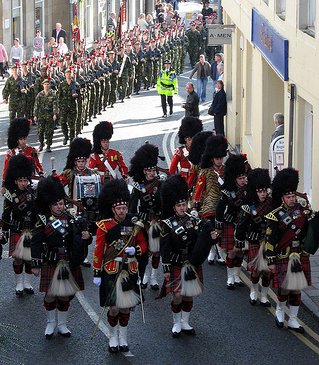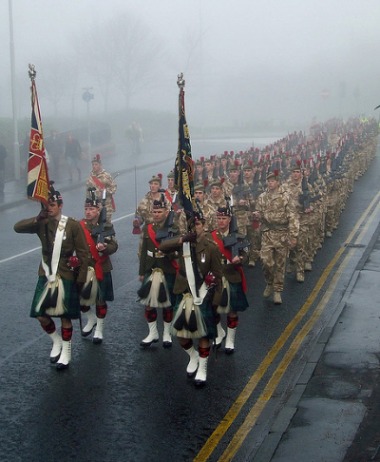|
The Black WatchThe Black watch is the most famous Scottish Regiment in British military history. So much so that their name is recognized around the world, and their reputation as a formidable fighting force is second to none. In fact they are the most highly decorated Regiment in the whole of the British armed forces. Their
tartan
which you can see below is equally famous, and is considered a generic tartan, which anyone can wear.
Black Watch Tartan They are Scotland's oldest, and best known Regiment, raised in the wake of the 1715 Jacobite rebellion. In 1725 six independent companies were formed, which were deployed across the Scottish Highlands to prevent fighting between the clans, to deter clans from raiding each others cattle, and to enforce the laws against the carrying of weapons. Fourteen years later, King George II authorized four additional companies, together they were then formed into a Regiment of the regular army. Their Colonel was the Earl of Crawford, who was instructed that all men had to be native Scotsmen, in order to enlist. Little did they know that they had just formed, what was to become the most famous and revered Regiment in the world. During the first World War their fearsome reputation on the battlefield, led them to acquire the nickname "Ladies from Hell", from the German soldiers who faced them in the trenches. The Regiment's title "The Black Watch" was taken from their dark tartan, and their original role to "watch the Highlands". Although it was originally a nickname it was officially incorporated into the Regiment's name in 1881, which then became "the Black Watch (Royal Highland Regiment)". The Regimental motto is Nemo me impune lacessit (no man attacks me with impunity). Due to the royal designation, the Regimental pipers wear the Royal Stewart Tartan. The photo below shows them receiving the freedom of Fife, the photo was taken by Duncan Cumming, who was kind enough to allow me to use it.
The 3rd Battalion Black Watch The late Queen mother, was the Regiment's Colonel in Chief from 1937 until her death in 2002. Prince Charles took over as Colonel in Chief from 2003-2006. In 2006 the Regiment lost its Regimental status when it was amalgamated with five other former Scottish regiments to form the Royal Regiment of Scotland. Unbelievably it has been reported that the newly formed Royal Regiment of Scotland are suffering from a
shortage of kilts.
They have however retained their famous name and are now officially known as "The Black Watch (3rd battalion Royal Regiment of Scotland)". As well as retaining their name they have also been permitted to retain another of their famous symbols, the red hackle, which is worn on their bonnets. The photo below clearly shows the red hackle being worn on their bonnets, as they march out of the mist. The Officers in full dress uniform, can be seen carrying the former Regiment's battle honours.
Marching Through the Mist photo Brian blob59 Flickr It is worth bearing in mind that former Scottish Regiments such as this, played a huge part in bringing the kilt to the attention of the world. It was the Scottish Regimental Highland Dress that ensured the survival of the kilt. In fact they wore their kilts in battle right up until 1940, and to this day the kilt is still ceremonial dress for the Royal Scottish Regiment One of the most famous photos ever to be seen on the internet, was that of a soldier belonging to this Regiment, during the handing over ceremony of Hong Kong to China. That photo made it clear beyond any doubt, what a Scottish soldier wears beneath his kilt. So it is in a large part due to Scottish Regiments such as this, that the world still has the famous Scottish National Dress. As after the battle of Culloden the wearing of kilts and all tartan was banned, the two exceptions being the Gentry, and the Scottish Military. If it weren't for the military, the kilt could well have been lost to the world, and what a loss that would have been. Return from Black Watch to Scottish Kilts |






